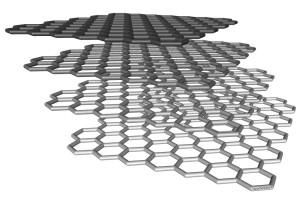
Graphene discussions prominent in Ideas for Change Conference.
During the 20th century, new textile polymers, chemicals and manufacturing methods came thick and fast—until 2005, when the WTO (World Trade Organization) dismantled the tariff system for textiles, and the race to ever-cheaper manufacturing provided little incentive for R&D in consumer textiles.
Today, textile innovation is being driven primarily by the industrial sector, bringing us performance textiles, protective textiles, smart textiles, and eco textiles—some of which eventually find their way into the mainstream. But the textile industry is ripe for disruption.
The “wonder material”
During New York Textile Week in July, the Ideas for Change Conference explored some of the ideas that may hold the potential to move the industry forward. Perhaps the most interesting—and much discussed as the wonder material of the 21st century—is graphene.
Graphene is a microscopic layer of carbon atoms in a honeycomb matrix about 0.3 nanometers thick that has captured the imagination of the scientific community. It is said to be stronger than steel, yet highly flexible; an excellent conductor of heat and electricity; anti-static and bacteriostatic; self-extinguishing and impermeable to gases, yet with a large surface area, making it highly adsorbent.
The topic of graphene was introduced at the conference by Razvan Popescu, COO of Directa Plus, an Italian company established in 2005 to develop nanomaterials and technologies. The company owns patents for manufacturing graphene nano-platelets (GNPs), which Popescu explained as a “top-down, low-cost, high-volume” manufacturing process. The inaugural module is producing 30 metric tonnes/year of these GNPs, called Graphene Plus (G+™).
In follow-up communication, Popescu explained the differences between the G+ technology, and the “bottom-up” process of growing a graphene monolayer, which typically has low productivity at a higher cost.

The most popular method of growing graphene, CVD (chemical vapor deposition), deposits heated gases onto a substrate such as copper foil or silicon. The solidified graphene monolayer must then be peeled off the substrate; or the substrate can be etched or dissolved away.
There are several problems with the CVD method, including the slow speed of coating the substrate, the prospect of damaging the graphene monolayer in the separation process, and toxic by-products of the process.
In comparison, in the G+ production method, “we start from natural graphite (widely available on industrial scale) and by using a patented super-expansion technology (ratio >300) we are exfoliating small packages of GNPs with a thickness of 2-4 nm. This is a low-cost, high-yield production method,” says Popescu.
Graphene Plus has already been commercialized in bicycle rims and tires, in thermo-conductive silicones used in high power LEDs, and as a recyclable “super sponge” for the absorption of organic pollutants.
IDTechEx, a market research firm specializing in emerging technologies, forecasts a US$100m market for graphene in 2018, with applications including RFID, super-capacitors, and composites.
Smart textiles and graphene
The use of graphene to develop conductive fibers for smart textiles has been regarded as the “killer app” to commercialize graphene as well as wearable tech. An international team of scientists from the Centre for Graphene Science at the University of Exeter, the Institute for Systems Engineering and Computers, Microsystems and Nanotechnology (INESC-MN) in Lisbon, the Universities of Lisbon and Aveiro in Portugal and the Belgian Textile Research Centre (CenTexBel) recently published a study in Scientific Reports claiming to have developed a technique to embed transparent, flexible graphene electrodes into textile fibers.
According to the report, the graphene was grown by CVD on copper foil, and transferred on to polypropylene fiber.
Team leader Dr. Helena Alves, from the University of Aveiro, told Engineering & Technology Magazine, “The concept of wearable technology is emerging, but having fully textile-embedded transparent and flexible technology is currently non-existent. Therefore, the development of processes and engineering for the integration of graphene in textiles would give rise to a new universe of commercial applications.”

Other uses in textiles
But there are other applications for graphene in the textile industry beyond smart textiles. Believing that “the use of graphene in the textile sector has so far been somewhat overlooked,” the Hohenstein Institut für Textilinnovation is currently leading a project in Bönnigheim, Germany, which is exploring how the surface of textiles can be altered though graphene modifications for personal protective equipment (PPE).
The Hohenstein research consortium is working to develop stable techniques for applying aqueous graphene dispersions as a permanent coating on different textile surfaces. Graphene oxide (oxidized graphite exfoliated in water) is hydrophilic and easily dispersed in water or other organic solvents.
According to project manager Dr. Roshan Paul, graphene modification of a textile surface could not only improve its flame-resistant qualities, but prevent the penetration of heat and gases, and the decomposition (burning) of the fabric. Graphene’s resistance to abrasion and rupture means that all of these qualities could be added to PPE textiles in one lightweight application.
Another team member, the company Fuchshuber Techno Tex, will attempt to convert the application to industrial scale, and ensure that the treated textiles can be cleaned and processed.
“If their functionality can be successfully proven, textiles with graphene-modified surfaces could find many uses in the PPE sector, especially in heat-protective clothing,” said Dr. Paul.
Short or long-term?
While work in academia and laboratories is promising, there would still appear to be a long road ahead to the use of graphene in commercial textiles. However, successful commercialization will depend not only on a killer app, but also on a low-cost, scalable supply of the appropriate type of graphene. Directa Plus hopes that GNPs are the answer.

According to Popescu, Directa Plus G+ nano-platelets are applicable to textile surfaces by means of a binder, mostly urethane; the ratio of GNP to binder would be somewhere between 4 and 10 percent.
Directa Plus has already produced polypropylene, polyamide, and polyester master batches with different GNP loadings. Popescu believes the yarns are capable of providing super conductive properties, both electrical and thermal; as well as IR shielding, bacteriostatic properties, and self-extinguishing barriers.
“We are now producing the first industrial batches of PP containing GNPs at different loadings. The end-uses are different, from antistatic to thermally conductive yarns to other applications covered by NDA,” he revealed.
Directa Plus is also working on graphene solutions that can be printed on textiles to provide conductivity, thermal dissipation, or antistatic properties.
“We have several ongoing projects with different major international brands and I do expect, in 6-12 months from now to see the first prototypes available at the major shows,” promised Popescu.
Debra Cobb is a freelance writer based in North Carolina with a broad background in the textile industry.
 TEXTILES.ORG
TEXTILES.ORG


